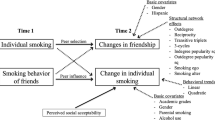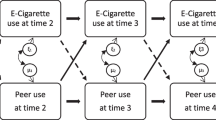Abstract
This study adds to the collegiate substance use literature by measuring the magnitude of peer effects upon individual cigarette use. The study employs data from the 2001 Harvard School of Health College Alcohol Survey to construct this peer effect measure and to study the effect of other variables upon a university student’s decision to smoke. The main finding of this paper is that moving a student from a university where no students smoke to an institution where 25 percent of the population smokes increases that student’s probability of smoking by 10.71 percent. The results of this paper suggest the potential for universities to institute student-led, anti-smoking organizations.
Similar content being viewed by others
Notes
ImpacTeen 2005. Toll of Tobacco in the United States of America.
The economic work on substance use is quite large. To list all relevant works here is unnecessary. Becker’s work alone in the area would require more bibliographical entrants that are present in this study as it stands.
Kawaguchi (2004).
Manksi (1993); Powell et al. (2005). An example of this masking effect is the following: The price of cigarettes increases by 25 percent in a given state. A prominent member of a peer group quits smoking because of this price increase. The rest of the individual’s peer group also quits smoking, not because of the price increase, but because smoking is no longer as popular due to their friend quitting. One could easily mistake this decrease in smoking behavior to be attributed to the price increases when in fact the peer effect measure caused the majority of this fall in smoking levels.
Powell et al. 2005.
References
Becker, G. S., Grossman, M., & Murphy, K. M. (1994). An empirical analysis of cigarette addiction. The American Economic Review, 84(3), 396–418.
Becker, G. S., & Murphy, K. (1988). A theory of rational addiction. The Journal of Political Economy, 99(4), 722–742.
Chaloupka, F. (1991). Rational addictive behavior and cigarette smoking. The Journal of Political Economy, 99(4), 722–742.
ImpacTeen (2004). Tobacco Control Policy and Prevalence Data: 1991–2001. Retrieved July 29, 2004, from http://www.impacteen.org/tobaccodata.htm.
ImpacTeen (2005). Toll of Tobacco in the United States of America. Retrieved December 7, 2005 from http://www.tobaccofreekids.org/research/factsheets/pdf/0072.pdf.
Kawaguchi, D. (2004). Peer effects on substance use among American teenagers. Journal of Population Economics, 17(2), 351–367.
Kremer, M., & Levy, D. M. (2003). Peer effects and alcohol use among college students. National Bureau of Economic Research. NBER Working Papers: 9876.
Levine, P. B, Gustafson, T. A., & Velenchik, A. D. (1997). More bad news for smokers? The effects of cigarette smoking on wages. Industrial and Labor Relations Reviews, 50(3), 493–509.
Lundborg, P. (2005). Having the wrong friends? Peer effects in adolescent substance use. Journal of Health Economics, Jun 15. [Epub Ahead of Print]. doi:10.1016/j.jhealco.2005.02.001.
Manski, C. F. (1993). Identification of endogenous social effects: The reflection problem. Review of Economic Studies, 60, 531–542.
Norton, E. C., Lindrooth, R. C., & Ennet, S. T. (1998). Controlling for the endogeneity of peer substance use on adolescent alcohol and tobacco use. Health Economics, 7, 439–453.
Powell, L. M., Tauras, J. A., & Ross, H. (2005). The importance of peer effects, cigarette prices and tobacco control policies for youth smoking behavior. Journal of health Economics, 24(5), 950–968.
Sacerdote, B. (2001). Peer effects with random assignment: Results of Dartmouth roommates. Quarterly Journal of Economics, 116(2), 681–704.
Wechsler, H., Harvard School of Public Health College Alcohol Study (2001). [Computer file]. ICPSR04291-v1. Boston, MA: Harvard School of Public Health [producer], 2005. Ann Arbor, MI: Inter-university Consortium for Political and Social Research [distributor], 2005-08-08.
Acknowledgement
Thanks to Francesco Renna for all his assistance with this study. Thank you also to my readers Steven Myers, Randall King, Doug Brewer, Alexander Butler, Monika Dutka, and Jared Miller for all the additional assistance and input.
Author information
Authors and Affiliations
Corresponding author
Additional information
Jeffrey Wilson was the first place winner of the Undergraduate Best Paper Award Competition at the 62nd International Atlantic Economic Conference in Philadelphia, PA, October 5–8, 2006.
Appendix of Tables
Appendix of Tables
Rights and permissions
About this article
Cite this article
Wilson, J. Peer Effects and Cigarette Use Among College Students. Atl Econ J 35, 233–247 (2007). https://doi.org/10.1007/s11293-007-9064-z
Received:
Accepted:
Published:
Issue Date:
DOI: https://doi.org/10.1007/s11293-007-9064-z




